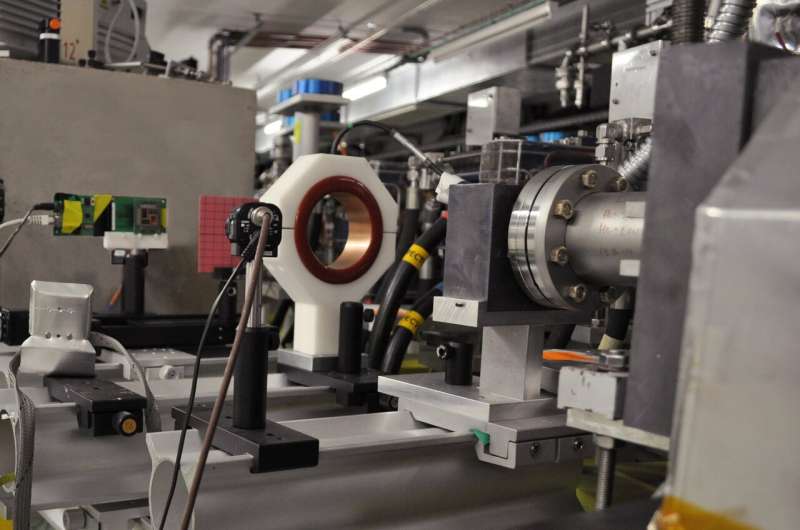Credit: CERN
This test facility at CERN, the European Organization for Nuclear Research, was used to simulate the high-radiation environment surrounding Jupiter to prepare for ESA's JUICE mission to the largest planet in our Solar System.
All candidate hardware to be flown in space first needs to be tested against radiation: space is riddled with charged particles from the Sun and further out in the cosmos. An agreement with CERN gives access to the most intense beam radiation beams available—short of traveling into orbit.
Initial testing of candidate components for ESA's JUpiter ICy moons Explorer, JUICE, took place last year using CERN's VESPER (Very energetic Electron facility for Space Planetary Exploration missions in harsh Radiative environments) facility.
VESPER's high energy electron beamline simulated conditions within Jupiter's massive magnetic field, which has a million times greater volume than Earth's own magnetosphere, trapping highly energetic charged particles within it to form intense radiation belts.
Due to launch in 2022, JUICE needs to endure this harsh radiation environment in order to explore Callisto, Europa and Ganymede—moons of Jupiter theorized to hide liquid water oceans beneath their icy surfaces. JUICE is being built by Airbus for ESA, with construction of its spacecraft flight model due to begin next month.
Last month ESA and CERN signed a new implementing protocol, building upon their existing cooperation ties.
Signed by Franco Ongaro, ESA's Director of Technology, Engineering and Quality, and Eckhard Elsen, CERN Director for Research and Computing, this new agreement identifies seven specific high-priority projects: high-energy electron tests; high-penetration heavy-ion tests; assessment of commercial off-the-shelf components and modules; in-orbit technology demonstration; 'radiation-hard' and 'radiation-tolerant' components and modules; radiation detectors monitors; and dosimeters and simulation tools for radiation effects.
"The radiation environment that CERN is working with within its tunnels and experimental areas is very close to what we have in space," explains Véronique Ferlet-Cavrois, Head of ESA's Power Systems, EMC & Space Environment Division.
"The underlying physics of the interaction between particles and components is the same, so it makes sense to share knowledge of components, design rules and simulation tools. Plus access to CERN facilities allows us to simulate the kind of high-energy electrons and cosmic rays found in space. At the same time we are collaborating on flying CERN-developed components for testing in space."
Petteri Nieminen, heading ESA's Space Environments and Effects section adds: "Along with JUICE, CERN heavy-energy radiation testing will also be useful for our proposed Ice Giants mission to Neptune and Uranus. The spacecraft may have to be pass through Jupiter's vast magnetic field on the way to these outer planets, and both worlds have radiation belts of their own.
"And the ability to simulate cosmic rays benefits a huge number of missions, especially those venturing beyond Earth orbit, including Athena and LISA as well as JUICE. It is also a huge interest for human spaceflight and exploration to study radiobiology effects of heavy ion cosmic rays on astronaut DNA. Not to mention that radiation simulations developed in collaboration with CERN help set space environment specifications for all ESA missions."
Provided by European Space Agency
























